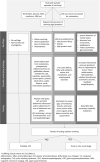Cyclic Vomiting Syndrome in Children
- PMID: 33224097
- PMCID: PMC7667239
- DOI: 10.3389/fneur.2020.583425
Cyclic Vomiting Syndrome in Children
Abstract
Cyclic Vomiting Syndrome (CVS) is an underdiagnosed episodic syndrome characterized by frequent hospitalizations, multiple comorbidities, and poor quality of life. It is often misdiagnosed due to the unappreciated pattern of recurrence and lack of confirmatory testing. CVS mainly occurs in pre-school or early school-age, but infants and elderly onset have been also described. The etiopathogenesis is largely unknown, but it is likely to be multifactorial. Recent evidence suggests that aberrant brain-gut pathways, mitochondrial enzymopathies, gastrointestinal motility disorders, calcium channel abnormalities, and hyperactivity of the hypothalamic-pituitary-adrenal axis in response to a triggering environmental stimulus are involved. CVS is characterized by acute, stereotyped and recurrent episodes of intense nausea and incoercible vomiting with predictable periodicity and return to baseline health between episodes. A distinction with other differential diagnoses is a challenge for clinicians. Although extensive and invasive investigations should be avoided, baseline testing toward identifying organic causes is recommended in all children with CVS. The management of CVS requires an individually tailored therapy. Management of acute phase is mainly based on supportive and symptomatic care. Early intervention with abortive agents during the brief prodromal phase can be used to attempt to terminate the attack. During the interictal period, non-pharmacologic measures as lifestyle changes and the use of reassurance and anticipatory guidance seem to be effective as a preventive treatment. The indication for prophylactic pharmacotherapy depends on attack intensity and severity, the impairment of the QoL and if attack treatments are ineffective or cause side effects. When children remain refractory to acute or prophylactic treatment, or the episode differs from previous ones, the clinician should consider the possibility of an underlying disease and further mono- or combination therapy and psychotherapy can be guided by accompanying comorbidities and specific sub-phenotype. This review was developed by a joint task force of the Italian Society of Pediatric Gastroenterology Hepatology and Nutrition (SIGENP) and Italian Society of Pediatric Neurology (SINP) to identify relevant current issues and to propose future research directions on pediatric CVS.
Keywords: anticonvulsants; antiemetics; cyclic vomiting syndrome; differential diagnosis; episodic syndromes that may be associated with migraine; functional gastrointestinal disorders; migraine; vomiting.
Copyright © 2020 Raucci, Borrelli, Di Nardo, Tambucci, Pavone, Salvatore, Baldassarre, Cordelli, Falsaperla, Felici, Ferilli, Grosso, Mallardo, Martinelli, Quitadamo, Pensabene, Romano, Savasta, Spalice, Strisciuglio, Suppiej, Valeriani, Zenzeri, Verrotti, Staiano, Villa, Ruggieri, Striano and Parisi.
Figures
References
-
- Li BU, Lefevre F, Chelimsky GG, Boles RG, Nelson SP, Lewis DW, et al. . North American society for pediatric gastroenterology, hepatology, and nutrition consensus statement on the diagnosis and management of cyclic vomiting syndrome. J Pediatr Gastroenterol Nutr. (2008) 47:379–3. 10.1097/MPG.0b013e318173ed39 - DOI - PubMed
-
- Heberden W. Commentaries on the History and Causes of Diseases, 3rd ed London, UK: Payne and Foss, 1806 [cited by Hammond J. The late sequelae of recurrent vomiting of childhood. Dev Med Child Neurol. (1974) 16:15–22. - PubMed
-
- Gee S. On fitful or recurrent vomiting. St. Bartholomew's Hospital Rep. (1882) 18:1–6.
Publication types
LinkOut - more resources
Full Text Sources



